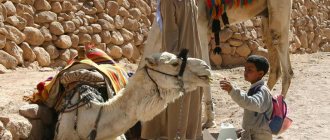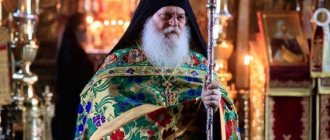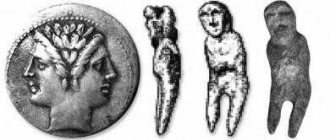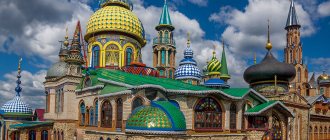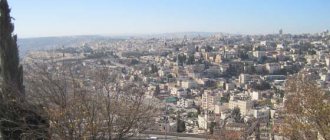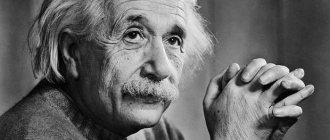We are accustomed to the fact that the inhabitants of the Arabian Peninsula profess Islam. However, this was not always the case, and answering the question: what religion do the Arabs profess was once very difficult.
The fact is that before the advent of Islam they adhered to paganism. At that time, each Arab tribe had its own gods, and there were about 360 of them in total.
Nowadays, the Arab world overwhelmingly professes Islam. However, some Arabs may also be Christians.
Arabs: Sunnis, Shiites, Christians
Arabs are a group of peoples of the Semitic ethno-linguistic group inhabiting the states of the Middle East and North Africa.
The approximate number of Arabs is 430-450 million people. Arabs speak Arabic and use Arabic writing.
430 - 450 million
approximately how many Arabs live on earth
The term Arabs began to be used to designate the nomadic Bedouins of northern Arabia already in the 9th century. BC e. The Arab world includes countries with a majority Arab population: Algeria, Egypt, Jordan, Iraq, Yemen, Lebanon, Libya, Mauritania, Morocco, Saudi Arabia, Syria, Sudan and Tunisia.
Almost 430 million people live in the Arab world, 416 million of whom are Arabs.
Arab city of Shafraim, Israel. In Arab cities you can meet representatives of different faiths. Photo: farm2.staticflickr.com
The population of the Arab world does not have a common origin, despite the fact that the early history of Arab culture was associated with the Arabian Peninsula. The fact is that for many centuries in the Middle East and North Africa there was an Arabization of many peoples, mainly through Islam.
Arabs are mainly of the Indo-Mediterranean race of the large Caucasian race, with sub-Saharan Arabs living in the sub-Saharan region. The Arab world also includes a number of non-Arab minorities, which include, for example, Berbers and Tuaregs, Iraqi Kurds, Jews, Armenians, Copts, etc.
90%
so many Arabs practice Islam
Arabs are among the most numerous peoples in the world, along with the Chinese, they are most common in the following countries (as migrants): France, USA (see also Arab Americans), Spain, Japan, South Korea, Canada, Mexico, Argentina, Brazil, Australia, Indonesia, Great Britain, Sweden, Estonia, Ukraine, Mongolia, Georgia, Ireland, Norway, Denmark, Germany, Austria, New Zealand, South Africa, Malaysia, Italy and Finland.
In these countries, the total number of Arabs exceeds 45 million people, a significant number of them are in France (6 - 8 million). The growth of the Arab community in different countries of the world is mainly due to migrants, while 10 thousand Arabs live in Russia, which is the smallest immigrant group of Arabs.
Most Arabs are Muslims, the rest profess Christianity.
Member States of the League of Arab States. More than 90% of Arabs profess Islam, some are Christian. This is worth knowing when answering the question: what kind of faith do the Arabs have?
However, most Arabs profess Sunni Islam. Shia Arabs live mainly in Iran, Iraq, Syria (Druze and Nusayris), Lebanon, Kuwait, Bahrain, UAE, Saudi Arabia, Yemen, etc.
The Ibadis live in the Arab countries of the Persian Gulf and North Africa. Among the Christian Arabs are the Maronites and Orthodox Christians of Lebanon, the Melkites of Lebanon, Syria, Jordan and others.
In the Arab world, Bedouins are any tribes that lead a nomadic lifestyle.
Arabs are divided into three main groups: nomadic pastoralists (Bedouins), peasant farmers (Fellahi), villagers and townspeople, and city residents. Arab cities, unlike rural areas, are multi-religious.
Story
Historical evidence from Mesopotamia begins to separate the Arabs from their other Semitic neighbors no earlier than the 1st millennium BC. At that time, the Arabs of southern Arabia had already created prosperous cities and kingdoms, such as Saba at the southern tip of the Arabian Peninsula. Western Arabia in the era of Christianity was inhabited by townspeople and nomads who spoke Arabic and considered their origins to go back to the biblical patriarchs (usually Ismail, see also the Hagarians), and in the city of Mecca they worshiped idols in a temple first built, presumably, by Abraham .
By - centuries AD northern and southern Arabian civilizations fell into decline. However, at the beginning of the seventh century, a merchant from Mecca, Muhammad, had the inspiration to begin preaching the revelations that served to create Islam. Under Muhammad and his successors, the caliphs, Islam swept the entire Middle East (see Arab Caliphate).
And a hundred years after the death of Muhammad, the territory of the spread of Islam extended from Spain through North Africa and southwest Asia to the borders of India. The spread of Islam provided the Arabs with a network of useful contacts, and together with dependent peoples - Christians, Jews, Persians, etc. - they built one of the greatest civilizations.
The period from the 8th to the 12th centuries marked the beginning of a body of Arabic literature in the form of poetry and prose, a brilliant tradition of art, elaborate legal codes and philosophical treatises, a rich palette of geographical and historical research, and scientific progress in the fields of astronomy, medicine and mathematics.
In the first centuries of its existence, the Arab empire was politically unified under the rule of the caliphs, but by the middle of the century it began to fragment and soon fell victim to the Crusaders, Mongols and Turks.
In the 16th century The Ottoman Turks conquered the entire Arab world, dividing it into provinces of the Ottoman Empire.
In the 19th century England and France effectively established control over most of North Africa while demands for Arab independence grew in Egypt and Syria.
During the First World War, the British organized an uprising against the Ottoman Empire in Arabia. The Arabs assisted the British in the conquest of Syria and Palestine in hopes of gaining independence after the war, but instead fell under complete control of the British and French. Arab demands for independence and unification were renewed. European rule stimulated modernization, but at the same time it resulted in the settlement of the French in the best lands of Algeria and European Jews in Palestine.
During and after World War II, all Arab peoples except the Palestinians eventually achieved full independence, although the Algerians did so only after eight years of war from 1954 to 1962. Since 1991, various agreements between Israel and the Palestine Liberation Organization (PLO) began to be put into effect; these agreements outline measures for future Palestinian self-government.
Before the adoption of Islam, Arabs were pagans
Many tourists and history buffs ask: what religion did the Arabs have before Islam?
To answer this, you need to know that Islam arose among the Arabs in the northwestern region of the Arabian Peninsula at the beginning of the 7th century.
VII
Islam appeared in the northwestern region of the Arabian Peninsula at the beginning of this century
Moreover, before its appearance, the Arabs were familiar with the religion of neighboring peoples: Judaism and Christianity. They gained knowledge about them while visiting Israel and Judea. The Arabs themselves had no single state or organized political power. By religious beliefs, the Arabs were pagans.
Idolatry was widespread. Each tribe had its own god in the form of some kind of animal or sculpture made of stone or wood. Such figures could be found in the mountains, near water sources.
Dushara is a deity of the ancient Arabic pantheon. Before the advent of Islam, the Arabs had many gods. Photo: upload.wikimedia.org
Mecca played an important role in the religious life of the pre-Islamic Arab world. It housed the ancient Kaaba temple, especially revered by the Arabs. A “black stone” was set into the eastern corner of the temple. This gave the temple a special holiness.
As a sign of veneration of the temple, many tribes placed their stone gods - idols - in it. In total there were about 360 of them. The guardians of the Kaaba were the Quraysh, they had the keys to the temple, they provided the pilgrims with food, water, and clothing.
At the same time, fairs were held in Mecca, where merchants made all sorts of trade transactions, receiving large financial income from them.
Before the rise of Islam, the Arabs had three hundred and sixty idols.
The Kaaba Temple was made of gray stone about 12 - 15 meters high. In the center of the Kaaba stood Hubal - the main idol of the temple, according to the Arabs themselves, he had the ability to cause rain. There were also idols in the temple in the form of women, animals, and birds. Gifts were brought to the Kaaba and it was decorated.
On religious holidays, the ritual of animal sacrifice was widespread. Many pilgrims flocked to Mecca, who performed the rite of purification and prayed for three days.
Wealthy people of the Quraish tribe lived in the center of the city, in rich neighborhoods; newcomers and less wealthy people settled on the outskirts.
Al-Khpram Mosque and Mecca in the 18th century. In the pre-Islamic period, Mecca was of great importance for the Arabs who practiced paganism. Today it is the holy city of Muslims. Photo: upload.wikimedia.org
Today, Mecca is the holy city for Muslims. It is located in the emirates (United Arab Emirates). Non-Muslims are prohibited from entering or entering it.
For modern Arabs, Islam is practically the only religion, so it is impossible to meet pagan Arabs in our world. You need to know all this in order to understand what religion arose among the Arabs before Islam.
Chapter first. Religious views of the ancient Arabs
To properly understand the Holy Quran and the Messenger of Allah, it is necessary to become more familiar with the conditions in which the Holy Prophet Muhammad (peace be upon him) had to preach.
According to early Arabic tradition, after Allah expelled Adam and Eve from paradise for their disobedience, Adam ended up in the mountains of Sri Lanka, and Eve ended up on Mount Arafat. After a hundred years of long wanderings, they met again in Mecca, where Adam, guided by the instructions given by the Lord, built a temple, which later received the name Kaaba, laying at its foundation the famous Al-Aswad, or “Sacred Black Stone”, which fell from paradise together with the sinful couple. Initially, this stone was whiter than milk, however, over time it turned black from the sins of the pilgrims who touched and kissed it (98, p. 7).
According to one philosophical tradition, this sacred stone used to be Adam's guardian angel. And because this angel was careless and lost his vigilance, Iblis (Satan) was able to persuade Adam to disobey Allah. Because of this, Adam fell from paradise, and his guardian angel turned into stone and fell after him (131, p. 30). Thus, Adam was the first to build the Kaaba, and later, after his death, it was rebuilt by his son Seth.
Tradition also claims that Mecca stands just below the throne of Allah, established in heaven, and that the Kaaba is an exact copy of the temple in which the angels in heaven offer their prayers to Allah. The Kaaba is a cubic structure 45 feet high (1 ft = 30 cm), its name itself translates as cube.
Arab historians claim that after the flood, Shem, one of the descendants of Noah, settled on the Arabian Peninsula, giving rise to several nomadic tribes. One of Shem's grandsons was Qatan, and Qatan's grandson Yarab created the state of Yemen. The word Arab comes precisely from the name of this descendant of Shem (66, p. 6).
During the Flood, the Kaaba, rebuilt by Seth, was flooded (51, p. 5). It was rebuilt by Abraham and his son Ismail. For the new construction of the Kaaba, Archangel Gabriel (Hazrat Gabriel; Alaihis-salam, may peace be upon him) brought Abraham a flat stone (Makam Abraham) on which Abraham himself stood, and which he used as a movable stand when he rebuilt the Kaaba. This stone rose into the air and fell to the ground, as Abraham required, it was enough to simply give the appropriate instruction. To this day, Abraham's footprints remain on this stone. This stone is kept in a steel box, before which all pilgrims bow (98, p. 133).
When the temple was almost finished, Abraham decided to place a miraculous stone in one of its corners so that pilgrims would begin their ritual circumambulation of the Kaaba from this stone. At this time, Archangel Gabriel showed the Sacred Black Stone, lost during the last destruction of the Kaaba. It was laid in the south-eastern corner of the Kaaba. After some time, the Kaaba again underwent reconstruction, which was carried out by members of the Amalek clan, descendants of Noah. The Kaaba was then rebuilt by Banu Jurhum, also a former descendant of Noah, and then, 700 years before the revelation of the Holy Quran, it was rebuilt by Qusay ibn Kilab, who led the Quraish tribes to Mecca. According to historian Azraki, at that time the Kaaba reached a height of 4.5 meters. It was without a roof, and in all its four corners there were various stones to which worship was shown.
Today, the Black Stone and the Kaaba are revered as shrines dedicated to the service of God since time immemorial. It is towards the Kaaba that Muslims turn their faces when reciting prayers. Thus, the Kaaba is a spiritual center that helps people focus their consciousness on the Divine Presence. You can pray inside the Kaaba itself, turning your face in any direction. The Black Stone is located in the southeast corner, installed at a height of 1.5 meters from the floor. It is black in color with a reddish tint; on its surface you can see yellow oval-shaped inclusions, about 20 cm wide and 38 cm long. This Stone is set in silver on the right. In the opposite corner there is another stone, set lower, it is reddish in color. This is Hajar As-Sa Adah (Stone of Happiness). The center of the Kaaba marks the direction of the kiblah, and all ritual prayers are concentrated in it.
Thus, the Kaaba was first built by Adam for the worship of the One Lord. It was called the "House of Allah." It is also called “Al-Bayt Al-Haram”, which means “The Holy House” and “Al-Bayt Al-Atiq” - “The Ancient Abode”.
This is how the ancient Arabs accepted the Almighty God and worshiped Him. However, they also believed that some people have a special relationship with Allah, and when such a person asks for someone, Allah pays more attention to his prayers than if an ordinary person asked. Therefore, the inhabitants of Mecca made images of various saints and righteous people, so that with their help it would be easier to attract the attention of Allah and achieve His help. Thus, the inhabitants of Mecca began to make images of saints and righteous people and worship them. They also performed various sacrifices for them to please Allah through them (70. com. 1).
In ancient times, the Arabs also believed that Allah made all kinds of demigods and demigoddesses responsible for various parts of the universe and for the processes occurring in it. Therefore, people always turned to them, no matter what enterprise they started (96. p. 22). They asked them to pray for them before Allah, informing Him of their wishes. The Arabs who inhabited the Syrian Desert considered Al-Manat, the “Goddess of Prosperity and Fortune,” the wife of Allah and the mother of all gods. Some deities, such as Al-Lat "Goddess of the Sky" and Al-Uzza - "Goddess of Venus" were considered daughters of Allah (78, p. 27). The people of Yemen worshiped the sun. Some tribes worshiped the moon, others the stars. However, idolatry prevailed in most tribes, and almost every tribe had its own idol. At Jumat-ul-Jandal, in the north of Nijaz, there was a temple of Wadda. His statue was an image of a man carved from stone and covered with two pieces of cloth. On his shoulders he carried a sword and mace, a quiver full of arrows on his back, and a spear with a small flag attached near the tip in his hand.
The goddess Al-Manat had her temple in Qudaid, on the sea coast, halfway between Mecca and Medina. Her image had two swords. The goddess Al-Lat was in Taif, she was worshiped by the Bani Thaqif tribe who lived in this city. The idol had the shape of a cube carved from stone. Al-Uzza, whose temple was located in the Nakhla Valley, not far from Mecca, was no less popular (87, p. 21).
In Hijaz and Hajd, the Arabs worshiped stones called baytullah, "House of Allah." People walked around the stone and touched it with their hands, poppy, so that part of the power that was contained in it could pass to them. There were stationary and portable baytullahs. Nomadic tribes carried their baitulla from place to place on the backs of camels, and the priestesses played drums and sang hymns. In addition to all these deities and stones, the Arab tribes also revered their ancestors (41, p. 20).
The ancient Arabs believed that if you make an image of a god or goddess and perform the necessary rituals, the gods themselves will enter into their images. People worshiped not only idols, but also various types of living beings and natural phenomena. Angels, genies, various spirits and stars were all their deities. They believed that angels are the daughters of Allah, and jinn are his divine partners (21, p. 20). They also worshiped various stones, trees and sand dunes. They bowed before any beautiful stone and prayed to the dunes, having first milked the camel's milk into their sand. When going on any journey, they took four stones with them, three for making a fire, and one for worship. Sometimes a special stone was not taken on the day of worship. Upon completion of cooking, people took one stone from the fire and worshiped it (97, p. 14).
Some tribes worshiped fire, others worshiped the male and female reproductive organs, and thirdly, some people with power made their own statues and forced others to worship them (90, p. 17). Sometimes people made idols from dates, which they then often ate when times of famine came (124. p. 8). The ancient Arabs had such terrible customs as, for example, sacrificing newborn girls, or burning her alive.
Gradually the Kaaba lost its original influence and Mecca lost its significance. Seeing this, the city authorities decided to place in the Kaaba the very influential deity Hubal (162, p. 21), which was brought from Moab, Palestine. This deity held seven arrows in his hands, which were used to predict the future. Thanks to this, the Kaaba became a famous place of pilgrimage, and in order to make it even more attractive to the Arab tribes, the inhabitants of Mecca gradually began to add more and more idols to the Kaaba. Soon there were already 360 various idols in and around the Kaaba itself. The deities of Al-Lat, Al-Manat and Al-Uzza were beautifully dressed and adorned with various jewelry. Wadd, Sheba, Yagus, Yauk and Nasr were also highly revered deities. Muslim historians claim that these idols were worshiped even before the Great Flood. Wadd was the personification of the sky and had a male form. Sheba was a woman, Yagus looked like a lion, Yauk looked like a horse, and Nasr looked like a vulture. There was also another idol, a large dove, carved from wood.
The ancient Arabs worshiped these deities by offering incense, jewelry, food, etc. They washed them with fragrant water, honey and the blood of sacrificed animals. In front of the entrance to the Kaaba there were two statues: a male and a female - Isaf and Naila. Tradition tells that one day this young couple, while still human, wanted to enjoy intimacy and, not finding a better place, entered the Kaaba and desecrated it with a disgusting sin. For this, Allah punished them by turning them into stone. Later, people placed their petrified bodies in front of the entrance to serve as a warning to others. However, the ignorance of the people was so great that even these statues began to be considered deities and began to be worshiped (119, p. 118).
Frescoes were painted inside the Kaaba, among which were Abraham and the Virgin Mary with the baby Jesus (119. p. 13).
According to custom, the Arabs had to walk around the Kaaba seven times, while being completely naked. Men walked around during the day, and women at night.
Of course, the ancient Arabs believed in Allah, the Lord of Earth and Heaven, but they did not worship him. They worshiped idols, thinking that they would give them everything they needed: they would send rain, harvest, wealth and bring their prayers to Allah.
Thus, from this excursion into the history of the ancient Arabs it can be understood that the principles of true religion were gradually forgotten and perverted. And people began to worship anyone and anything, except the Supreme Lord. It was in these conditions that the Holy Prophet Muhammad (may peace be upon him) appeared to restore the true religious principles. And because the people of that time worshiped many falsely fabricated deities. The Holy Prophet Muhammad (peace be upon him) strictly forbade the worship of them, but with the passage of time, his followers began to reject all deities, regardless of whether they are true or not.
Sunni Arabs follow the path of the Prophet Muhammad
Almost 90% of Muslim Arabs are Sunnis, that is, “people of the Sunnah and the consent of the community”). The name Sunnis comes from the self-name “Ahl al-Sunnah wal-Jama'a”. The first part (ahl al-sunnah) implies following the path of the prophet Muhammad and his companions, since one of the main meanings of the word sunna is “path”.
90%
so many Arab Muslims are Sunnis
For Sunnis, the Koran and Sunnah are the primary sources of religion; they solve various problems on the basis of clear and unambiguous verses of the Koran and Hadith, and in their absence, on the basis of the arguments of their reason (ijtihad).
The second part of the name (wa-l-jama'a) implies recognition of the community and mission of all the companions of the Prophet and following their method in solving various problems.
Areas of distribution of the main currents of Islam. green: Sunnis, red: Shiites, purple: Ibadis. Most Arab Muslims are Sunnis. Photo: upload.wikimedia.org
The term "jama'a" first became known after Hasan ibn 'Ali transferred power in the Caliphate to Mu'awiya I. The year in which the civil war ended went down in history as the "year of unity" (sanat al-jama'a).
During the life of the Prophet Muhammad and the first three Rightly Guided Caliphs, the Muslim community (ummah) was united. After the assassination of Caliph 'Uthman (656), a split occurred in Muslim society, which deepened even more during the confrontation between Ali and Muawiya.
The founders of the moderate path in these conditions were Ibn 'Umar, Ibrahim an-Nahai, Hassan al-Basriya Abu Hanifa and other Islamic theologians.
Sunnis strictly follow the life path of the Prophet Muhammad.
Sunnis number more than 1 billion 550 million people. Sunnis place special emphasis on following the Sunnah of the Prophet Muhammad (his actions and sayings), on loyalty to tradition, on the participation of the community in choosing its head - the caliph.
Compared to Shiism, Sunnism has a clearer content - it is following the life path of the Prophet Muhammad. Shiism only recognizes the right to succession of the descendants of Ali as the spiritual and secular head of the Muslim community
Seal of Ibn Umar, companion of the Prophet Muhammad, son of Caliph Umar. Ibn Umar is one of the founders of Sunnism. Photo: upload.wikimedia.org
Despite the fact that Arabs - supporters of Sunnism and Shiism - are Muslims, representatives of these directions often conflict with each other. Many conflicts in the Middle East occurred precisely for this reason.
At the same time, it is worth noting that Arab governments can support one of these areas at the state level.
The emergence of Islam
Islam appeared in the 7th century AD on the Arabian Peninsula, when the Arabs were experiencing the decomposition of the tribal system and the formation of separate groups of society. The process of emergence was not instantaneous, but gradual. According to one version, Islam appeared on the basis of the teachings of the Hanifs - this is the earliest form of Arab monotheism. Each tribe in Arabia had its own gods, but gradually the weaker tribes adopted the beliefs of their neighbors. This was due to the complication of economic and political relations and the emergence of centers of power.
The founding father of the religion is considered to be the Prophet Muhammad, who preached in Medina and Mecca. He preached only orally. After his death, his students wrote down their code, which was called the Koran. Muhammad's followers interviewed witnesses, recording the founder's sermons. This happened in 650, when Osman, the third follower of Muhammad, was in power.
The Koran is the holy book for adherents of Islam. Later, the Sunna appeared, which included sacred traditions (hadiths) dedicated to miracles, life, and teachings of the prophet.
Hadiths were compiled in the 9th century by several theologians, including Bukhari and Muslim. Interestingly, not all Muslims accept the Sunnah. Its adherents are called Sunnis, who outnumber Shiites.
Shia Arabs are a minority in the Islamic world
Shia Arabs are adherents of a branch of Islam that unites various communities that recognized Ali ibn Abu Talib and his descendants as the only legitimate heirs and spiritual successors of the Prophet Muhammad.
In a narrow sense, the concept usually means Twelver Shia, the predominant trend in Shiism, which is predominantly widespread in Iran, Azerbaijan, Bahrain, Iraq and Lebanon, as well as in Yemen, Afghanistan, Turkey, etc.
Mausoleum at al-Baki cemetery, destroyed in 1925. Four Shia imams were buried here - Hassan, Sajjad, Muhammad al-Baqir, and Jafar al-Sadiq. Shiites believe that only a descendant of a prophet, chosen by Allah, can lead the community of believers. Photo: upload.wikimedia.org
A distinctive feature of the Shiites is the belief that the leadership of the Muslim community should belong to imams - appointed by Allah, chosen persons from among the descendants of the prophet, to whom they include Ali ibn Abu Talib and his descendants from the daughter of Muhammad Fatima, and not elected persons - caliphs.
Shiites are critical of the caliphate of the first three caliphs Abu Bakr, Umar and Uthman. According to Shiites, the election of a leader - the imam of the Muslim community, like the election of prophets, is the prerogative of Allah.
Up to 20%
so many Muslims are Shiites
According to various estimates, Shiites make up from 10% to 20% of the total Muslim population. Currently, followers of various Shiite communities exist in almost all Muslim, European and American countries.
Shia Muslims make up the majority of the population in Iran, Azerbaijan, Iraq and Bahrain. In Saudi Arabia, 15% of the kingdom's population is Shia, who predominate in cities such as Qatif, Dammam and al-Hasa.
Shiites celebrate Ashura. In addition to general Muslim holidays, Shiites also celebrate their own holidays. Photo: upload.wikimedia.org
The predominant trend in Shiism is the Imami, among whom a split occurred into Twelver Shiites (Isna'Sharites) and Ismailis. Shiites are traditionally divided into two large groups: moderate (Twelver Shiites, Zaydis) and extreme (Ismailis, Alawites, Alevis, etc.).
Shiite holy places were often targeted or destroyed. For example, in February 2006, an explosion was carried out in the Golden Mosque (Al-Askari Mosque) in Samarra, as a result of which the golden dome of the shrine collapsed.
The concept of "din"
The concept of "din" has several meanings. This is a court, and personal faith, and a system of ritual practice, and retribution, and divine law. Mainly, din is the totality of religious instructions and the sincerity of their implementation by believers.
Faith is based on three elements:
- verbal recognition of Allah;
- good deeds;
- virtuous intentions.
Separately, five main subjects were identified in faith - faith in one God, angels, revealed books, prophets and messengers, Judgment Day, heaven and hell, retribution and punishment.
Then a sixth component was added to these objects of faith - belief in the predestination of everything on earth.
Christian Arabs are a minority in the Arab world
Christian Arabs are ethnic Arabs who profess Christianity. In total, there are 28 Christian denominations in the Middle East and North Africa, numbering about 15 million believers. Among Christian Arabs there are:
- Copts;
- Orthodox (belong to the Antiochian Orthodox Church, the Jerusalem Orthodox Church, the Alexandrian Orthodox Church);
- Maronites;
- Melkites;
- Chaldeans;
- Syro-Jacobites;
- Catholics;
- Protestants;
- Syro-Catholics;
- adherents of the Assyrian Church of the East.
John of Damascus, one of the Church Fathers.
That part of the Arabs that are not Muslims professes Christianity. Most Christian Arabs in the Middle East live in Egypt, Lebanon and Syria. Currently, the number of Christian Arabs living in Arab countries is constantly decreasing, while their numbers in the USA, Canada, Australia and Western European countries (mainly France and Great Britain) are growing.
This is connected both with the actions of Islamic radicals and with migration processes. In particular, there are about 4 million people from Arab countries living in the United States, and the vast majority of them are Christian Arabs. There are also large communities of Christian Arabs in Latin America.
The number of Christian Arabs is rapidly decreasing due to demographic processes.
Back in the 70s of the 20th century, Christian Arabs (primarily Maronites) made up the majority of the Lebanese population. Currently, their number does not exceed a million people.
A significant community of Christian Arabs lives in Syria, and there are also in Israel and Jordan. As of 1990, there were 1 million Christians living in Iraq. Currently (2005) - just over half a million.
Cemetery of Christian Arabs in Haifa. The number of Christian Arabs in the world has sharply decreased due to the peculiarities of the demographic process in the Arab world. Photo: upload.wikimedia.org
It is also worth noting the fact that among Europeanized Christian Arabs the birth rate is significantly lower than among Muslim Arabs. In particular, there has never been any significant emigration of Christian Arabs from Israel, but, nevertheless, their share of the country's Arab population is rapidly declining.
At the same time, the governments of different Arab states have different policies towards them. Some of them are trying to smooth over conflicts between Muslim Arabs and Christian Arabs, while others support radical Islamist groups.
By leaving a comment, you accept the user agreement
Key Populations
Most Bedouins live in Arabia and the neighboring desert regions of Jordan, Syria and Iraq, while some Bedouins live in Egypt and the northern Sahara. Their number ranges from 4 to 5 million. Bedouins lead a strictly tribal and nomadic lifestyle. The tribe and each of its parts is headed by a sheikh, considered the eldest in wisdom and experience. Bedouins are mainly engaged in camel breeding and sheep and goat farming.
Among the Bedouins there are both Christians and Shia Muslims, but the majority are nominally either Wahhabi or Sunni Muslims. Bedouins are not as religious as Muslims in villages and cities, but they regularly perform the five daily prayers prescribed by Islam. Because most Bedouins are illiterate, they cannot read the Koran themselves and must rely on oral transmission of religious ideas. Along with many people in villages and towns, they share a belief in the evil eye and evil spirits as the cause of illness and misfortune, and in the healing and protective powers of the tombs of various Muslim saints.
About 70% of Arabs live in villages and are peasants. Most Arab peasants have a deep sense of belonging to their village, whose inhabitants usually help each other in case of external threat. They are also united by religious holidays or funerals. But most of the time, the villagers find themselves divided into separate factions.
Arab cities are commercial, industrial, administrative and religious centers. Some of them are much like European cities, with large buildings, wide streets and heavy traffic. The traditional Arab city and those old areas of modern cities that still exist are characterized by narrow streets and closely packed houses, often with shops and workshops on the ground floors.
